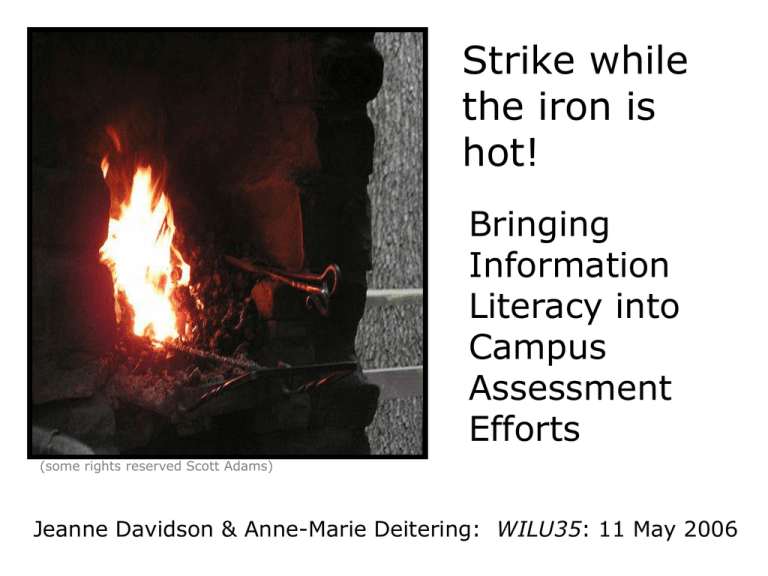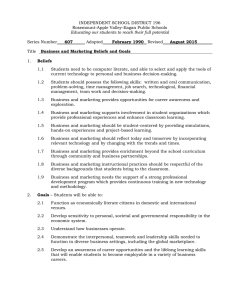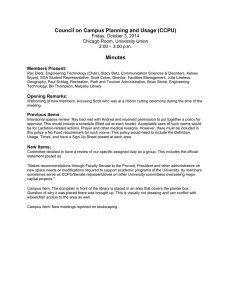Strike while the iron is hot! Bringing
advertisement

Strike while the iron is hot! Bringing Information Literacy into Campus Assessment Efforts (some rights reserved Scott Adams) Jeanne Davidson & Anne-Marie Deitering: WILU35: 11 May 2006 A few small tasks… Who’s watching? How we started Campus partners Results & next steps What we learned Accreditation is the means of self-regulation and peer review adopted by the educational community. The accrediting process is intended to strengthen and sustain the quality and integrity of higher education, making it worthy of public confidence and minimizing the scope of external control. -- MSCHE, Characteristics of Excellence in Higher Education how do you show you’re doing a good job? (some rights reserved Scott Adams) some rights reserved (Distinguish) Degree Program Proposal Checklist (Alberta Advanced Education, November 2005) NWCCU Standard Four: Faculty Required documentation for Standard 4, Adopted 1992, revised 2001 some rights reserved (Fez) Accountability Asking the right questions what questions should we be asking? (some rights reserved Scott Adams) Shifting focus From To inputs & outputs outcomes new program reviews iterative, ongoing assessment teaching learning Peggy Maki, Assessing for Learning Q U A L I T Y Looking at user communities from the perspective of the library. Looking at the library from the “customer’s” perspective. The library in the life of the institution. When the pressure to assess is on: Aligning with campus goals Defining what you bring to the table (some rights reserved Scott Adams) Striking while the iron is hot. About OSU 19,000 Undergraduate thru Ph.D. Land grant, publicly funded 7 Colleges Common baccalaureate core Library instruction program ACRL Standards –first try ACRL/ILCS were difficult to use. Our program was reactive & inefficient. Process itself proved useful. Meanwhile… Research as a Conversation eavesdropping entering engaging The information literate student determines the nature and extent of the information needed. The information literate student accesses needed information effectively and efficiently The information literate student evaluates information and its sources critically and incorporates selected information into his or her knowledge base and value system. The information literate student, individually or as a member of a group, uses information effectively to accomplish a specific purpose. The information literate student understands many of the economic, legal, and social issues surrounding the use of information and accesses and uses information ethically and legally. Successful learners… Recognize the need for information Find information efficiently Learn from information gathered Use information effectively Are you using information literacy competencies or standards? Some rights reserved (Be_Still) are you using information literacy competencies or standards ? (some rights reserved Scott Adams) Campus Conversations Shared goals Shared challenges Diversity Expertise Connections Conversations with faculty 6-9 per group Designate a notetaker & facilitator Script your questions Spend your time on key questions Listen! First draft Redraft Identify the parts of a citation that will lead them to a source of information, regardless of format Interpret a citation or reference to a particular book, article or other piece of information and use that reference to find the cited source. Understand the economic and legal place of information in a capitalist society and can weigh the costs and benefits of retrieving different pieces of information. Analyze the costs and benefits of retrieving particular information sources, recognizing that there may be economic, social, political or legal restrictions to consider. Results Librarians starting new conversations. Faculty extending the conversation. Stronger library-wide commitment to student success goals. Librarians’ expertise recognized. Faculty incorporating IL more broadly. Next steps next steps Some rights reserved (Malingering) Mapping outcomes to competencies Mapping to the curriculum Some rights reserved (Mr. Wind-up Bird) Curriculum survey “How can I teach this right now?” Learning Objects Classroom Assessment Techniques Faculty workshops Next next steps CATs competency quizzes assessments rubrics assignments outcome teaching tools lesson plans tutorials learning objects (Tracking use & placement in the curriculum) What we learned √ Strike while the iron is hot. √ Bring something to the table. √ Food brings people together. √ Tell others how they can help you. √ People need to see themselves in what you’re doing. http://hdl.handle.net/1957/1816 WILU35: Charting a course for instruction 11 May 2006





